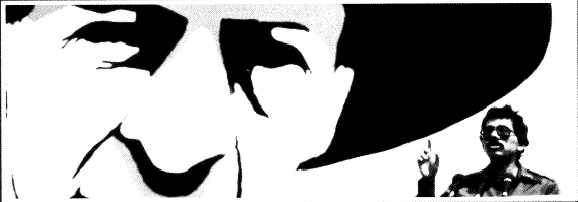N I C A R A G U A

1 9 7 8 - 1 9 9 0
Photo: Daniel Ortega, standing in front of a mural portraying Augusto Sandino.
(Susan Meiselas/Magnum
Photos).

Photo: Daniel Ortega, standing in front of a mural portraying Augusto Sandino.
(Susan Meiselas/Magnum
Photos).
The National Security Archive's Nicaragua collection documents the most controversial foreign policy issue in recent memory:
U.S. relations with the Sandinista Revolution. A detailed declassified history emerges from this set; from the overthrow of
Somoza, through the advent of the U.S.-sponsored Contras, to the February 1990 electoral defeat of the revolutionary
government.The collection provides the most comprehensive case study of intervention and revolution in
Central America currently available to the public.
Nicaragua, 1978-1990 contains over 3,500 documents totaling 13,000 pages, many of them recently declassified Department of
State cables obtained through the Freedom of Information Act. The collection provides a centralized source of documentation for
primary research and analysis of U.S. policy toward the Nicaraguan revolution from beginning to end. It is composed of
documents dating from 1978, when widespread opposition to the Somoza family dynasty became visible, through the decade
of the 1 980s, when Nicaragua emerged as a hotly debated foreign policy issue in the United States and abroad.
Hitherto inaccessible documents generated by the Contras, around whom much of the debate swirled, are also included.
Materials on the U.S. role in the Nicaraguan elections of February, 1990, which unseated the Sandinista party, complete the set.
Key events covered by the collection include: the U.S. attempt to mediate an end to the crisis between Anastasio
Somoza and political opponents of his rule in 1978; the U.S. Embassy effort to arrange the departure of Somoza, and orchestrate
the transition of power to the moderate opposition in July 1979; the Carter Administration's initial relations with the Sandinista
government; the advent and early history of the Contras; key Congressional votes on Contra aid between 1982 and 1988;
the efforts by the Contadora nations in Latin America to negotiate a peaceful end to the strife in Nicaragua; the
CIA's mining of Nicaragua's harbors in 1984; Nicaragua's first national elections under the Sandinistas in November 1984;
the Reagan Administration's imposition of a full trade embargo in 1985; the discovery of the Reagan Administration's illicit
contra resupply operations in 1986; and the Bush Administration's successful campaign, through the National Endowment
for Democracy, to defeat the Sandinista party in Nicaragua's February 1990 elections.
The Archive prepares extensive, printed finding aids for its collections. The Guide contains a detailed events chronology,
glossaries of key individuals, organizations, events, legal terms and acronyms, a selected bibliography of relevant secondary
sources and a document catalog. The catalog, organized chronologically, provides bibliographic information about the
documents and lists all the indexing phrases generated for each. This facilitates browsing through the document descriptions
and allows researchers to preview key details about documents before perusing the microfiche.
The Index contains rich contextual references to subjects, individuals and organizations. The detail provided in indexing allows
researchers to pinpoint relevant documents in particular areas of study.
Nicaragua, 1978-1990 offers a comprehensive case study of intervention and revolution in the Third World. In these primary
source documents--many of them cables between the State Department and U.S. Embassy in Managua, and only recently
declassified through the Freedom of Information Act--researchers will find a vast, untapped wealth of information on relevant
topics including:
Documents in this collection include:
Previously unpublished documents originate from:
Nicaragua: The Making of U.S. Policy, 1978-1990
Reproduces on microfiche 3,500 documents totaling over 13,000 pages recording U.S. policy toward Nicaragua from the overthrow of Somoza to the 1990 electoral defeat of the revolutionary government.
Documents are arranged chronologically. For ease of use, the unique identification numbers assigned to the documents are printed in eye-legible type at the top right hand corner and precede each document on the microfiche strip.
Documents are reproduced on silver halide positive- reading microfiche at a nominal reduction of 24x in envelopes. They are archivally permanent and conform to AIIM, BSI and ANSI standards. Any microfiche found to be physically substandard will be replaced free of charge.
A printed guide and index totaling over 1,000 pages accompanies the microfiche collection. The Guide contains an events chronology, glossaries of names and organizations, a bibliography of secondary sources and a chronological listing of documents. The Index provides in-depth, document-level access to subjects, individuals and organizations.
June 1991
Praise for Nicaragua, 1978-1990
"It is important to my work, as a scholar, that I have access to actual government documents ... such documents allow
me to have a more accurate understanding of events. In addition, students learn, from actual documents, how our government
makes foreign policy decisions. By publishing the Nicaragua collection the National Security Archive is providing an
invaluable service."
Rachel M. McCleary, Ph.D.
Lecturer, Department of Politics
Princeton University
"The declassified documents, which cannot be obtained anywhere else, are a boon to scholars in the field of American foreign policy."
Robert Kagan
Former Director Office of Public Diplomacy
Latin America and Caribbean
U.S. Department of State